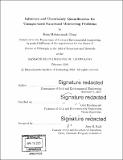Inference and uncertainty quantification for unsupervised structural monitoring problems
Author(s)
Mohammadi Ghazi, Reza
DownloadFull printable version (32.00Mb)
Other Contributors
Massachusetts Institute of Technology. Department of Civil and Environmental Engineering.
Advisor
Oral Büyüköztürk.
Terms of use
Metadata
Show full item recordAbstract
Health monitoring is an essential functionality for smart and sustainable infrastructures that helps improving their safety and life span. A major element of such functionality is statistical inference and decision making which aims to process the dynamic response of structures in order to localize the defects in those systems as well as quantifying the uncertainties associated with such predictions. Accomplishing this task requires dealing with special constraints, in addition to the general challenges of inference problems, which are imposed by the uniqueness and size of civil infrastructures. These constraints are mainly associated with the small size and high dimensionality of the relevant data sets, low spatial resolution of measurements, and lack of prior information about the response of structures at all possible damaged states. Additionally, the measured responses at various locations on a structure are statistically dependent due to their connectivity via the structural elements. Ignoring such dependencies may result in inaccurate predictions, usually by blurring the damage localization resolution. In this thesis work, a comprehensive investigation has been carried out on developing appropriate signal processing, inference, and uncertainty quantification techniques with applications to data driven structural health monitoring (SHM). For signal processing, we have developed a feature extraction scheme that uses nonlinear non-stationary signal decomposition techniques to capture the effect of damages on the dynamic response of structures. We have also developed a general purpose signal processing method by combining the sparsity based regularization with the singularity expansion method. This method can provide a sparse representation of signals in complex-frequency plane and hence, more robust system identification schemes. For uncertainty quantification and decision making, we have developed three different learning algorithms which are capable of characterizing the statistical dependencies of the relevant random variables in novelty detection inference problems under various constraints related to the quality, size, and dimensionality of data sets. In doing so, we have mainly used the statistical graphical models and Markov random fields, optimization methods, kernel two sample tests, and kernel dependence analysis. The developed methods may be applied to a wide range of problems such as SHM, medical diagnostic, network security, and event detection. We have experimentally evaluated these techniques by applying them to SHM application problems for damage localization in various laboratory prototypes as well as a full scale structure.
Description
Thesis: Ph. D. in Structures and Materials, Massachusetts Institute of Technology, Department of Civil and Environmental Engineering, 2018. Cataloged from PDF version of thesis. Includes bibliographical references (pages 261-272).
Date issued
2018Department
Massachusetts Institute of Technology. Department of Civil and Environmental EngineeringPublisher
Massachusetts Institute of Technology
Keywords
Civil and Environmental Engineering.